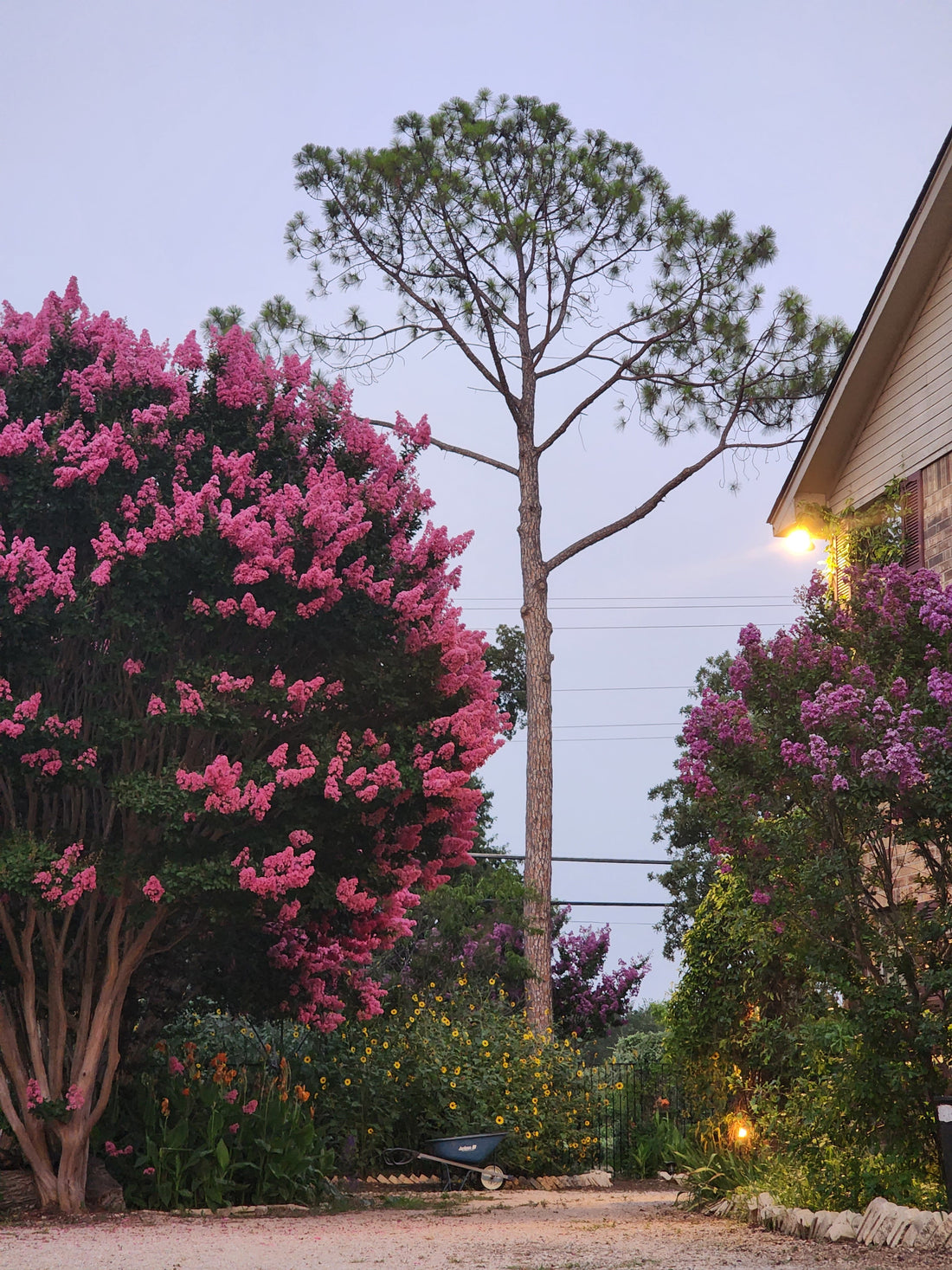15 Common Trees Every Texan Should Grow (Medicinal + Practical Edition)
Bismillah. A tree for every purpose under the sun.
🌳 1. Willow (Salix spp.)
-
Medicinal Uses: Willow bark contains salicin, a precursor to aspirin, and has been used to alleviate pain, inflammation, and fevers. veriditashibernica.org+3The Sun+3The Outdoor Apothecary+3
-
Practical Uses: The flexible branches are ideal for weaving baskets and crafting furniture.Reddit+3Wikipedia+3Bushcraft USA+3
-
Identification: Look for slender, lance-shaped leaves and a preference for moist environments.
-
Preparation: Harvest bark from young branches in spring; dry and brew into tea.
🌲 2. Pine (Pinus spp.)
-
Medicinal Uses: Pine needles are rich in vitamin C and have been used in teas to treat respiratory issues. The resin possesses antiseptic properties. The Outdoor Apothecary+1veriditashibernica.org+1
-
Practical Uses: Pine wood is commonly used in construction, and the resin can be utilized as a natural adhesive.
-
Identification: Identify by long needles grouped in clusters and the presence of cones.
-
Preparation: Collect fresh needles, rinse, and steep in hot water for tea.
🌿 3. Linden (Tilia spp.)
-
Medicinal Uses: Linden flowers are known for their calming effects, used to treat anxiety, insomnia, and colds. Healthy Green Savvy+4Wikipedia+4The Outdoor Apothecary+4
-
Practical Uses: The soft wood is suitable for carving, and the inner bark has been used to make ropes.The Outdoor Apothecary+4veriditashibernica.org+4Wikipedia+4
-
Identification: Recognizable by heart-shaped leaves and fragrant, pale-yellow flowers.
-
Preparation: Harvest flowers during bloom; dry and use for tea infusions.
🌰 4. Oak (Quercus spp.)
-
Medicinal Uses: Oak bark is astringent and has been used to treat diarrhea and inflammation. Wikipedia+1Wikipedia+1
-
Practical Uses: The durable wood is prized in furniture making and flooring.Reddit+1Cornell Cooperative Extension+1
-
Identification: Look for lobed leaves and acorns as fruit.
-
Preparation: Collect bark from young branches; dry and decoct for medicinal use.
🌸 5. Hawthorn (Crataegus spp.)
-
Medicinal Uses: Hawthorn berries and flowers support heart health, aiding in blood pressure regulation and circulation. Nitty Gritty Life
-
Practical Uses: The dense wood is used for tool handles and walking sticks.
-
Identification: Small trees with white or pink flowers and red berries.
-
Preparation: Harvest berries in late summer; dry for teas or tinctures.
🌼 6. Elderberry (Sambucus spp.)
-
Medicinal Uses: Elderberries are known for boosting the immune system and treating colds and flu. The Outdoor Apothecary+1veriditashibernica.org+1
-
Practical Uses: The berries can be made into jams, wines, and syrups.
-
Identification: Shrubs with clusters of white flowers and dark purple berries.
-
Preparation: Cook berries thoroughly before consumption to neutralize toxins.Wikipedia
🌾 7. Slippery Elm (Ulmus rubra)
-
Medicinal Uses: The inner bark soothes sore throats and digestive issues. The Outdoor Apothecary
-
Practical Uses: Historically used in the production of ropes and as a food thickener.Bushcraft USA
-
Identification: Large tree with rough bark and asymmetrical leaves.
-
Preparation: Harvest inner bark, dry, and powder for use in teas or lozenges.
🍁 8. Maple (Acer spp.)
-
Medicinal Uses: Maple sap is a natural sweetener and has been used as a tonic. The Outdoor Apothecary
-
Practical Uses: Maple wood is valued in furniture and flooring; sap is boiled to make syrup.
-
Identification: Distinctive lobed leaves and winged seeds known as samaras.
-
Preparation: Tap trees in early spring to collect sap; boil to concentrate.Practical Self Reliance
🌿 9. Sassafras (Sassafras albidum)
-
Medicinal Uses: Traditionally used to treat fevers and as a blood purifier. Verywell Health+6The Outdoor Apothecary+6basmati.com+6
-
Practical Uses: The aromatic wood is used in cabinetry; leaves are ground into filé powder for cooking.Wikipedia
-
Identification: Leaves come in three shapes: unlobed, mitten-shaped, and three-lobed.
-
Preparation: Use dried leaves for culinary purposes; root bark can be brewed into tea.
🌿 10. Manzanita (Arctostaphylos spp.)
-
Medicinal Uses: Leaves have been used to treat urinary tract infections and as a mild disinfectant. The Outdoor Apothecary+1Wikipedia+1
-
Practical Uses: The hard wood is used for tool handles and decorative items.
-
Identification: Shrubs with smooth, red bark and small, bell-shaped flowers.
-
Preparation: Leaves can be dried and used in teas; berries are edible when ripe.
🌲 11. Douglas Fir (Pseudotsuga menziesii)
-
Medicinal Uses: Needles and resin have been used in teas to treat colds and stomach ailments. The Outdoor Apothecary+1Wikipedia+1
-
Practical Uses: The wood is prized in construction for its strength and durability.
-
Identification: Tall conifer with thick bark and distinctive cone bracts.
-
Preparation: Collect young needles for tea; resin can be applied to minor wounds.
🌿 12. Senna (Senna auriculata)
-
Medicinal Uses: Used to treat constipation, diabetes, and skin conditions. Wikipedia
-
Practical Uses: Cultivated for ornamental purposes due to its bright yellow flowers.
-
Identification: Shrub with pinnate leaves and yellow blossoms.
-
Preparation: Leaves and pods are dried and used in teas or powders.
🌿 13. Ginkgo (Ginkgo biloba)
-
Medicinal Uses: Leaves are used to improve memory and circulation.
-
Practical Uses: Often planted in urban areas for its resistance to pollution.
-
Identification: Fan-shaped leaves and distinctive seeds with a strong odor.
-
Preparation: Leaves are dried and used in teas or extracts.
🌳 14. Cedar (Thuja spp.)
-
Medicinal Uses: Leaves and bark have been used to treat colds and skin infections. The Outdoor Apothecary
-
Practical Uses: Wood is valued for its resistance to decay, used in building and furniture.
-
Identification: Evergreen with scale-like leaves and small cones.
-
Preparation: Leaves can be infused for steam inhalation; wood used in construction.veriditashibernica.org+1The Outdoor Apothecary+1
🌿 15. Spicebush (Lindera benzoin)
-
Medicinal Uses: Bark and berries have been used to treat colds, fevers, and digestive issues. The Outdoor Apothecary
-
Practical Uses: Berries can be used as a spice substitute for allspice.
-
Identification: Shrub with aromatic leaves and bright red berries.

